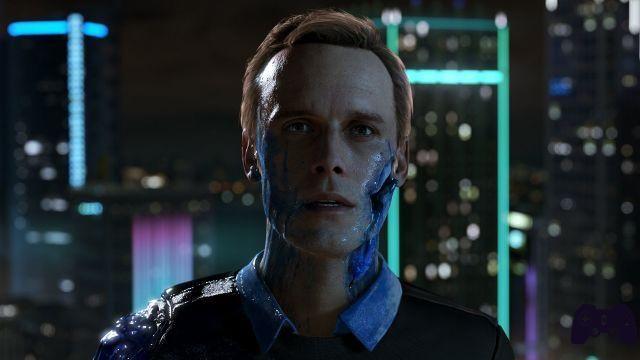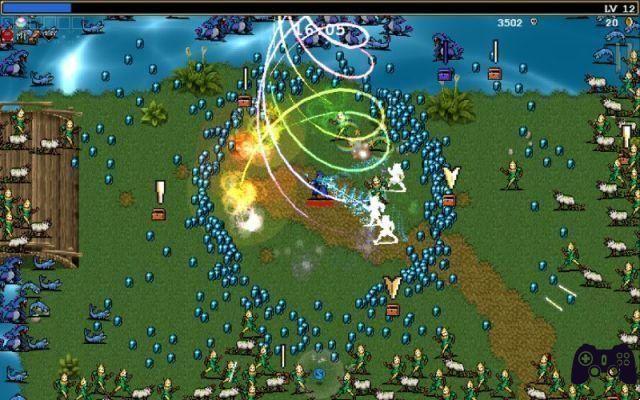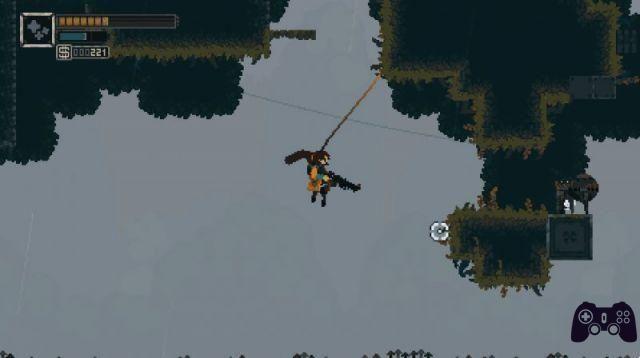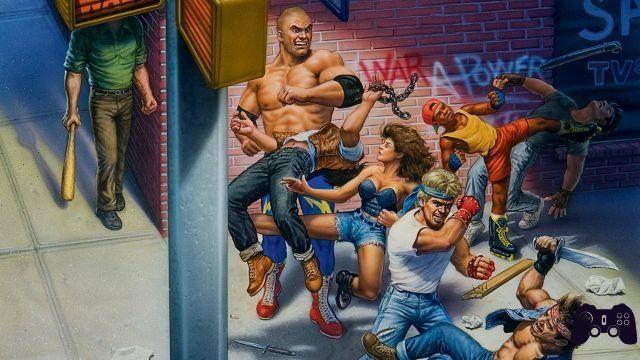
The history of Streets of Rage is littered with incredible successes and failures
- Streets of Rage - a story of urban violence
- Streets of Rage 2 perfection
- Streets of Rage 3 - The black sheep of the family
- Streets of Rage - canceled chapters and fan love
- 2020: the year of rebirth
After 26 years of deafening silence, the series of Streets of Rage has finally done justice to its story thanks to the fourth chapter developed by Lizardcube, DotEmu and Guard Crush Games. Streets of Rage 4 managed to break the curse that had fallen on the series after the first three chapters. SEGA had by now put the series in a sad hibernation, going to abort what on balance is one of the most important IPs in its war on Nintendo. Streets of Rage made school and was what is perhaps one of the best representations of the street culture of the late 80s.
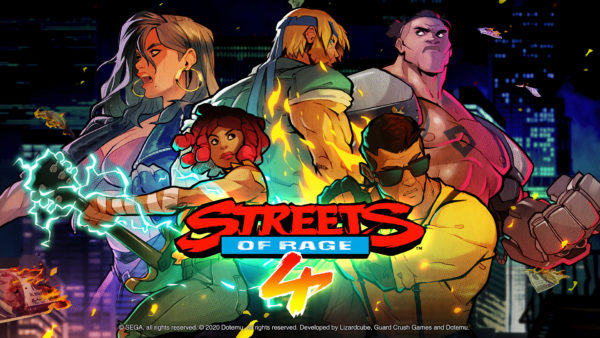
To learn more:
Streets of Rage 4 - a slap in the face of nostalgia
Streets of Rage was a flag for SEGA and witnessed the happiest time in its history. It arrived in the homes of fans in one of the best historical periods ever for Sonic's mother, who with the Mega Drive was giving serious trouble to the Super Nintendo of the great N. SEGA was constantly on the lookout for titles that could put Nintendo in trouble, and to do so he could count on the only area where he had a clear advantage: the games room. The idea that led to the birth of Streets of Rage came precisely from the arcade rooms of the first half of the 90s, which at that time were overflowing with horizontal scrolling Beat em Up.
In the beginning it was Double Dragon
It is true that SEGA was the queen of the arcade, but her dominance was prevalent on the hardware side only. Challenging Nintendo in the field of beat em ups was not a simple matter, since the Kyoto house hosted on its consoles the best titles of the genre since the days of the NES. From Double Dragon to the titles of the series Kunio Kun, Nintendo has always had third-party IPs to exploit on their machines. In the room, however, SEGA's glorious Aero City cabinets hosted several titles developed by Capcom, which 2 had flooded theaters around the world with its best games and was preparing to release one of the greatest planetary hits in history: Street Fighter 2.
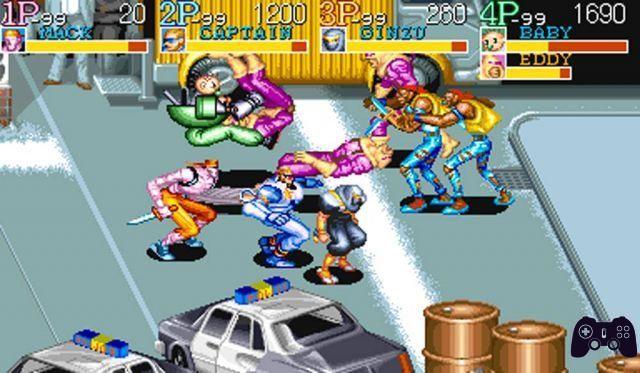
The Capcom-branded beat 'em up offering was frighteningly varied. It passed from the feudal settings of Dynasty wars to the blows in sci-fi sauce di Captain commando, without forgetting pearls of the caliber of Cadillacs and Dinosaurs o Knights of the Round. But there was one title that most of all had captured the attention of critics and audiences: Final Fight. Not content with having grinded tons of 100 Yen coins in theaters, Capcom decided to bring it to Super Nintendo as well, leaving the SEGA machines orphaned of one of the most loved titles of the time. Final Fight was incredibly beautiful, had gigantic and divinely animated sprites, plus its urban settings were manicured and had captured the interest of fans all over the world.
SEGA, for its part, couldn't stand by and watch. SEGA had to somehow respond to Capcom's overwhelming power, especially in light of the almost exclusive partnership with the hated Nintendo.
Streets of Rage - a story of urban violence
Dragon SWAT The initial project was to create a sequel to ESWAT called DSWAT, but going into development the team changed their mind and opted for the creation of a totally new IP
SEGA rolled up their sleeves and sought inspiration to take on Final Fight. The important thing was that that killer application came from an internal team, so it was decided to lay the foundations of the game on the only thick beat 'em up published by SEGA on Mega Drive: Golden Ax. The project was entrusted to two key figures of the SEGA team of that period: Noriyoshi Ohba as game director e Yuzo Koshiro to the soundtracks. Ohba and Koshiro had been a huge hit with Revenge of Shinobi, and were highly regarded by SEGA of Japan executives. It was Ohba who decided to base the development on the Golden Ax engine, adapting it to their needs in the most functional way. The sifda with Final Fight had to fight on an equal footing, so we eliminated the fantasy elements of Golden Ax in favor of an urban setting that was dirty and dangerous.
Streets of Rage didn't want to be innovative
He wanted to be better
A difficult choice The three protagonists have different characteristics and abilities, and offer a diversified approach to combat
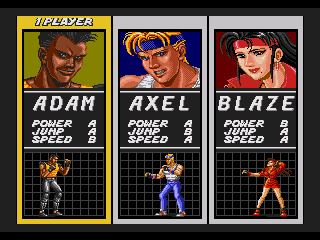
Ohba was an extremely capable designer and had long dreamed of trying his hand at creating an urban brawler. Final Fight was first and foremost an inspiration for him and his team, who alternated working hours with compulsive viewing of American TV series such as Starsky & Hutch and A-Team. Everyone's intention was to create a title that wasn't necessarily groundbreaking, but that was recognizable and, ideally, better than the competitive games it was inspired by.
Streets of Rage offered eight stages, to be played with one of three selectable characters: Axel Stone, martial arts expert, Adam Hunter, puggile of success, e Blaze Fielding, skilled judoka. All three are ex-cops who have abandoned the corrupt police in order to fight the obscure mala syndicate led by Mr.X, which has disturbed the peace of the unnamed city where the game is set.
Streets of Rage did not win the comparison with Final fight, which still remained much more beautiful to look at on an aesthetic level, but it came close and, above all, he made himself known. The sprites were smaller and less detailed than those of Capcom, and the animations were much less accurate, yet Streets of Rage had shown that it knew how to do it. It did so thanks to the incredible beauty of its backgrounds (which enjoy that wonder that was the parallax on SEGA titles) and to the crazy soundtrack composed by Yuzo Koshiro and Motohiro Kawashima. Furthermore, Streets of Rage could count on multiple endings and local Co-Op, that Capcom had been forced to remove from Final Fight when porting to Super nintendo.
Streets of Rage 2 perfection
Incorrect, very incorrect SEGA of America created what is arguably the most ingenious and videogame incorrect marketing campaign in the history of the medium
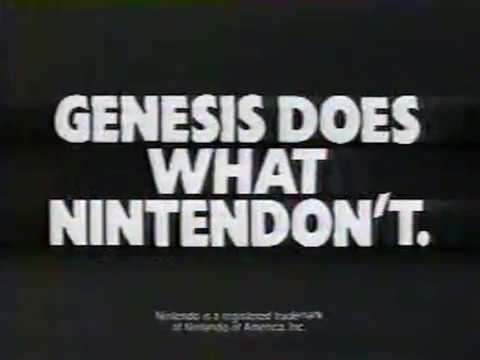
If you think back to the story of Streets of Rage it makes you smile to think that the most loved chapter by all has risked never to see the light. To understand why, however, we need to take a step back and look at SEGA's corporate organization. SEGA had two divisions, SEGA of Japan and SEGA of America, both quite autonomous and led by different presidents who operated in the two reference continents. It is from this division that the problems that led to the SEGA crisis and the anticipated death of consoles like Saturn and Dreamcast arose, yet it was SEGA of America that saved Streets of Rage and guaranteed the enormous success of Genesis (known both at home and in Europe. such as Mega Drive).
At the time of Streets of Rage's launch, SEGA of America was led by one of the most important figures in the history of the video game, that Tom Kalinske to which we owe, among other things, the aggressive anti-Nintendo advertisements that have made the history of console wars, including that immortal Genesis does what Nintendon't forcibly sculpted in the annals of gaming. Contrary to what many think, Mega Drive was a little-loved console in Japan. It was Tom Kalinske and his aggressive marketing campaigns that decreed its success in America and around the world.
Kalinske understood one fundamental thing
Kalinske realized that Streets of Rage was the least Japanese Japanese game on the market and that, by virtue of the influences of American culture on the development of the first chapter, the series could sell a lot in the USA. History proved him right, and while Bare Knuckle did not register dizzying sales in Japan, Streets of Rage had arrived in the homes of many Americans who had literally fallen in love with Axel, Blaze and Adam. The lack of success of the series in Japan, however, led the leaders of SEGA of Japan to want to abandon the project, admitting defeat with Nintendo and Final Fight. It was Kalinske himself, following countless intercontinental phone calls to his Eastern colleagues, to impose itself and press for the realization of a sequel made by the same team responsible for the creation of the first chapter.
Streets of Rage was safe, but now he had to outrun the competition
After the porting of the first chapter on SEGA Master System and, incredibly, also on Game Gear (the game also came out on 3DS), Ohba got back to work. It was flanked as usual by the combination of Koshiro / Kawashima on the soundtracks and this time it was supported by a significantly higher budget and by the collaboration of companies such as Ancient (founded by Yuzo Koshiro himself), Shout! Designworks and MNM Software. Streets of Rage 2 had to start from the very solid foundations of the first chapter and had to improve in everything. It was difficult, but he really succeeded.
Streets of Rage 2 was no longer just a Final Fight clone
The new bigger budget and, above all, the help received from Ancient and MNM software brought Streets of Rage to an impressive quality level. Streets of Rage 2 was better in all respects: the sprites were huge, the animations were better, the backgrounds were even more accurate and the soundtrack of Koshiro and Kawashima was just perfect. It should be emphasized that the entire Yuzo Koshiro family played a role of fundamental historical importance in Streets of Rage 2. Yuzo in fact founded Ancient together with his mother, Tomo Koshiro, and his sister Ayano, who was in charge of character design.
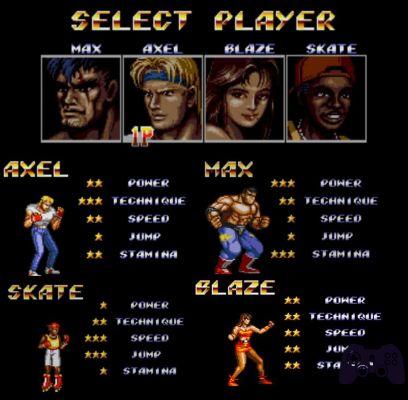
It was Ayano who reworked the roster of characters, adding new enemies, and, above all, two new protagonists: Skate e Max. According to Ayano's statements, Max is his tribute to his brother Yuzo, who particularly appreciated the characters from the moveset based on tricks. Skate instead was included in the game to expand the variety of protagonists, and was a character designed explicitly for the more experienced players.
Streets of Rage 2 no longer looked to Final Fight, it had emancipated itself and earned its rightful place in the history of SEGA. The gameplay was improved and made even more fluid and fun. Not only, Ohba had the courage to take a risk eliminating elements characteristic of the first chapter such as the smart bomb to insert new mechanics that make the pace of the game even more fluid. Unfortunately, the multiple endings were eliminated, but a competitive mode was added that allowed two players to compete in a fight to the death. Also in this case, porting on Master System and Game Gear followed one another, up to the version for Nintendo 3DS)
Tom Kalinske had won his battle against SEGA of Japan.
Tom Kalinske was right.
Streets of Rage 3 - The black sheep of the family
One of the greatest virtues of Streets of Rage is that no two titles are alike in its history. The development team has always tried to improve each new chapter to differentiate it from the previous one, and have always managed to create perfectly recognizable titles. After the release of the second chapter two years passed before being able to see Streets of Rage 3. The problem is that those two years were the years that marked SEGA's commercial suicide.
In what was the era of the only true console war in history, SEGA had managed to scare Nintendo and its dominion over the planet, imposing itself with its Genesis on the American market. Kalinske's work was instrumental in establishing SEGA's brand in the world, but no one treasured his example, and SEGA of Japan embarked on a series of choices that brought the company close to bankruptcy.
Between 1992, the year Streets of Rage 2 was released, and 1994, the year in which the third chapter was released, SEGA entered a profound identity circuit. Mega Drive was a success, but SEGA of Japan supported it the wrong way due to the fear it had of competitive progress. In 1991 it came out SEGA MegaCD and in 1994 it was the turn of 32X, two very expensive add-ons that took away the purchasing power of fans in view of the imminent launch of SEGA Saturn, released in 1995. In all of this, SEGA of Japan was so convinced of Saturn's potential that they actually pulled the plug on Mega Drive when the console still had a lot to say. Streets of Rage 3 came out around this time and was the first illustrious victim of SEGA's confusion.
A deafening silence
The censorship The American and European versions of SOR3 are orphans of Ash, a miniboss too homosexual to be sold to the Western public
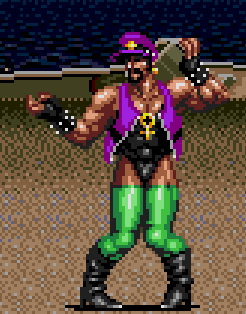
The history of Streets of Rage is littered with aggressive and over the top marketing campaigns. The first two chapters received incredible media support from the two divisions of SEGA, and it is also thanks to this that the series became so popular with players of the time. When it was time for Streets of Rage 3, however, the confusion SEGA had fallen into meant that the game was not supported in any way.. The game was launched almost by surprise, in a very uncomfortable market window and in an atmosphere spoiled by the fact that SEGA itself seemed more interested in the upcoming release of Saturn than in everything else.
This, coupled with the fact that for the first time the Japanese version and the one intended for the rest of the world were significantly different, made Streets of Rage 3 go unnoticed. The game sold very little and went to displease its privileged audience: the American one. If in fact SEGA of Japan did not seem to believe particularly in the series, on the other side of the ocean there was a whole continent of enthusiasts who didn't quite digest the fact that Bare Knuckle 3 was significantly better than Streets of Rage, which this time was also heavily censored. Not only that, the plot of the Western version was impoverished and the relative balance of difficulty underwent a distortion, as well as the design of the characters.
Streets of Rage 3 has no faults
In fact, Streets of Rage 3 continues that tradition of experimentation and innovation that have marked its history. In terms of gameplay this third chapter aims to improve the feeling of the previous one, including, among other things, a new playable character, Dr. Zan, and the more extensive and graphically curated internships. The real revolution, however, was brought by Koshiro and Kawashima, which competed with each other to develop an alternative vision to the traditional soundtrack. Koshiro and Kawashima came to conceive a new technique for composing and, explicitly inspired by Jeff Mills and the newly born trance music, based the entire soundtrack of the game on samples generated automatically by the computer. It was a revolution that unfortunately was received in a negative way by the public, but which anticipated the electronic music of that era.
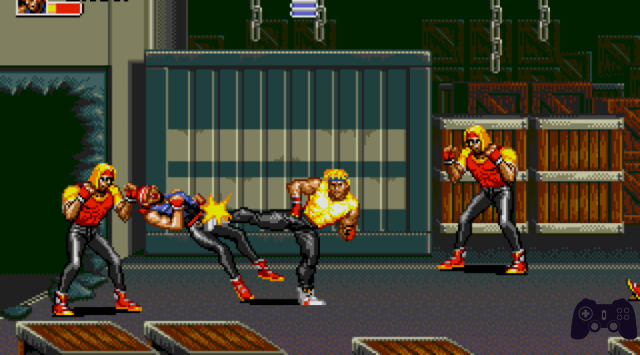
It's a shame that Streets of Rage 3 is almost universally considered a bad title. The fact is, Bare Knuckle 3 is actually a rock solid and damn fun game which was, however, a victim of the infamous management of the SEGA of the time. Its failure was the most evident symptom of the crisis that was mounting within SEGA and that would soon bring it one step away from the abyss. The result was a period of pitch darkness for the series, abandoned in a corner for many years waiting to return to shine on the screens of fans. For a long time it was believed that Streets of Rage 3 marked the death of the series.
The End…?
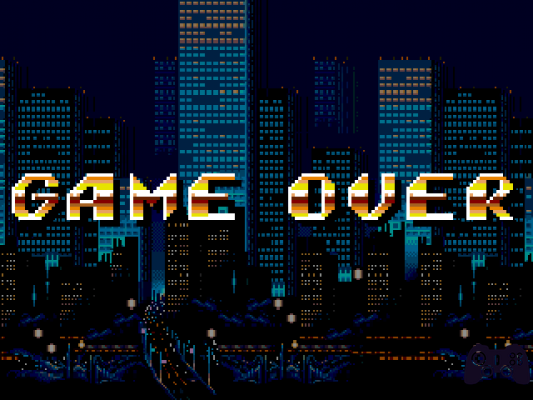
Streets of Rage - canceled chapters and fan love
Following the release of SEGA Saturn, Streets of Rage disappeared from the radar. In the period from 1994 to 2020, the year of release of the fourth chapter of the series on Playstation 4, sHowever, there have been many attempts to give new life to the franchise, starting with PS1. There were contacts between SEGA and Core Designs (the developers of tomb raider) to release a new chapter of the series - this time in 3D - on the newly created Sony console. The game was actually developed, but SEGA lost interest in the project, which came out as Fighting Force.
Next it was the turn of Dreamcast, which saw Ancient develop a new 3D chapter of Streets of Rage. There are short videos related to a preparatory build of the game, which show the return of some old acquaintances and, incredibly, also of first-person combat scenes. SEGA of America announced the death of the project by saying that, quite simply, they weren't interested in bringing Streets of Rage back to life.
At the time of Playstation 3 and Xbox 360 SEGA got in touch with Bottlerocket Entertainment to attempt a new assault on Streets of Rage history. The project was to entrust the design of the game to Roger Robinson, historical author and designer The Marvel movies, but even this idea was abandoned in the bud for no apparent reason. In 2010 SEGA returned to talk again about a project related to the series, this time developed using the graphics engine of Condemned. The game was supposed to be a sandbox, but fortunately he was aborted almost instantly.
Streets of Rage is dead, long live Streets of Rage.
It is useless to go around it: SEGA has longed for Streets of Rage to die for a very long time because it was convinced that the IP and the entire Beat 'em up genre had come to an end. The last traces of an official reboot of the series date back to 2012, but even for that project it all ended with a stalemate. Incredibly, however, in 2010, a team of enthusiasts went further.
Bomber Team began to develop a project that to define ambitious is an understatement: Streets of Rage Remake. The project was totally self-produced and included more than 100 playable stages, a roster of 12 characters and a soundtrack of 75 tracks remixed by 5 different musicians. After nine years of development, Streets of Rage Remake was released online, but SEGA requested its cancellation only 48 hours after the official release.
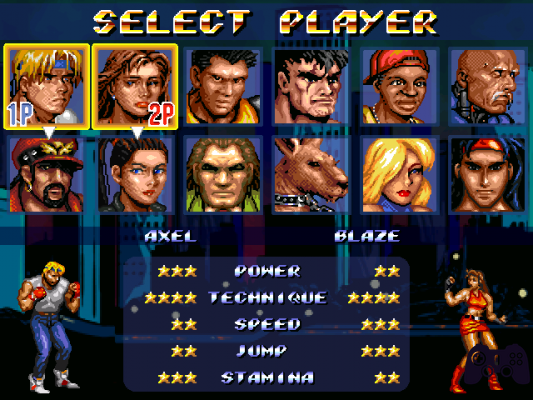
Not only that, in 2003 the network began to circulate Beats of Rage, a tribute to the series that incorporated sprites and characters taken directly from King of Fighters, giving rise to a mass phenomenon. Fans never wanted to accept the death of Streets of Rage, and created an open source version of the Beats of Rage engine, the hugely popular OpenBOR, to continue developing tributes to SEGA's IP.
2020: the year of rebirth
It took 26 years and at least four chapters canceled, but Streets of Rage is finally back. After the first trailer for Streets of Rage 4 in 2019, apprehension was spreading among fans. The work done by Lizardcube e DotEmu it seemed insufficient and generally poorly cared for. Then, finally, it landed on consoles, and oh my how good it is.
Nobody really believed in it and to be honest it seemed like yet another attempt at therapeutic persistence on a series that seemed really dead and buried, as well as cursed. Instead, the guys from Lizardcube made a small modern miracle, giving life to the series and reminding everyone that Streets of Rage is a piece of video game history and deserves respect. It's amazing, but we really did it.
We saved Streets of Rage, and we did it one punch at a time




